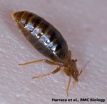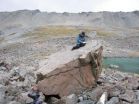Yeast holds clues to Parkinson's disease
2010-09-09
(Press-News.org) Yeast could be a powerful ally in the discovery of new therapeutic drugs to treat Parkinson's disease says a scientist presenting his work at the Society for General Microbiology's autumn meeting in Nottingham today.
Dr Tiago Fleming Outeiro from the Instituto de Medicina Molecular in Lisbon, Portugal describes how his group is slowly uncovering the molecular basis of Parkinson's disease by studying the associated human protein in yeast cells.
Parkinson's disease is a neurodegenerative disorder without any known cure that affects around 6 million people worldwide. The symptoms, which include rigidity, difficulty in initiating movements and resting tremors, are all related to the specific death of dopamine-producing neurons in the brain. These neurons characteristically contain protein deposits, known as Lewy bodies. A small protein called alpha-synclein is the main component of these deposits.
Dr Outeiro explains how baker's yeast, Saccharomyces cerevisiae, is helping researchers learn how alpha-synuclein might lead to Parkinson's disease. "Yeast is a very simple but powerful model in which to study how alpha-synuclein actually works as, remarkably, many of the biochemical pathways involved are similar between yeast and humans," he said. "There is still a lot we don't know about the function of this protein, but we do know that even small increases in the level of alpha-synuclein in cells lead to cell death."
Dr Outeiro, along with colleagues in the USA, screened a library of 115,000 small compounds to try and identify those that are able to block the toxic effects of alpha-synuclein. Several of these molecules have proved effective in preventing Parkinson's disease in worms and blocking alpha-synuclein toxicity in rat neurons. If developed further, they could form the basis of future drugs to treat Parkinson's disease in humans.
New treatments for neurodegenerative diseases are urgently needed. "With the ageing of the human population the number of people affected by Parkinson's disease will continue to increase. This means the disease will become an even greater problem for modern societies due to the tremendous socio-economic costs associated," Dr Outeiro said. "It's therefore imperative that treatments for such neurodegenerative diseases are developed. Our studies in yeast have enabled us make a step towards this."
INFORMATION: END
ELSE PRESS RELEASES FROM THIS DATE:
2010-09-09
In the latest issue of the journal Nature, Miguel Godinho Ferreira, Principal Investigator at the Instituto Gulbenkian de Ciência (IGC) in Portugal, lead a team of researchers to shed light on a paradox that has puzzled biologists since the discovery of telomeres, the protective tips of chromosomes: while broken chromosome ends generated by DNA damage (such as radiation or cigarette smoke) are quickly joined together, telomeres are never tied to each other, thus allowing for the correct segregation of the genetic material into all cells in our body. Since telomeres erode ...
2010-09-09
Male bedbugs are known to be very unfussy when it comes to mating, mounting any well-fed bug they can see - regardless of age or gender. Researchers writing in the open access journal BMC Biology have discovered how immature bedbug nymphs, who would be harmed by the traumatic insemination technique practiced by the males, release alarm pheromones to deter this unwanted attention.
Vincent Harraca, from Lund University, Sweden, worked with a team of researchers to stage encounters between males and females or nymphs. He said, "The chemical communication, as well as the ...
2010-09-09
By studying similarities in the genes of Scots Pine trees, scientists have shown that the iconic pine forests of Highland Scotland still carry the traces of the ancestors that colonised Britain after the end of the last Ice Age, harbouring genetic variation that could help regenerate future populations, according to new results published in the journal Heredity.
The research was carried out by an international team from the Centre for Ecology & Hydrology, the Polish Academy of Sciences, the University of Edinburgh and the Macaulay Land Use Research Institute.
Today's ...
2010-09-09
As the last ice age was ending, about 13,000 years ago, a final blast of cold hit Europe, and for a thousand years or more, it felt like the ice age had returned. But oddly, despite bitter cold winters in the north, Antarctica was heating up. For the two decades since ice core records revealed that Europe was cooling at the same time Antarctica was warming over this thousand-year period, scientists have looked for an explanation.
A new study in Nature brings them a step closer by establishing that New Zealand was also warming, indicating that the deep freeze up north, ...
2010-09-09
Cancer immunotherapy calls for revised clinical endpoints that differ from those used for chemotherapy, according to an article published online September 8 in The Journal of the National Cancer Institute.
Unlike chemotherapy, which acts directly on tumors, cancer immunotherapies exert their effects on the immune system, which may delay or change response patterns, perhaps owing to the dynamics of the immune system itself. For example, initial tumor burden may increase due to lymphocytic infiltration, because of T-cell proliferation, which is followed by lymphocyte-induced ...
2010-09-09
BOSTON, Mass. (September 8, 2010)‹Scientists have discovered a small
molecule that helps human cells get rid of the misfolded, disfigured
proteins implicated in Alzheimer¹s disease and other neurodegenerative
ailments. This potential drug could have applications for other conditions
as well.
Cells create and discard proteins continuously, a process that relies on a
balance between the speed with which new proteins are created and damaged
ones destroyed. Protein destruction occurs through a sophisticated system
that marks proteins for disposal by tagging them with ...
2010-09-09
LA JOLLA, CA - September 7, 2010 –A team of scientists from The Scripps Research Institute, the Genomics Institute of the Novartis Research Foundation (GNF), and the U. S. Naval Research Detachment in Peru has completed a study that could improve the efficacy of diagnosis and treatment strategies for drug-resistant malaria.
In the new study—published online on September 9, 2010 by the journal Genome Research—the scientists analyzed the genomic features of a population of malaria parasites in Peru, identifying the genetic basis for resistance to a common antibiotic.
Malaria ...
2010-09-09
GAITHERSBURG, Md. – Using a one-of-a-kind instrument designed and built at the National Institute of Standards and Technology (NIST), an international team of researchers have "unveiled" a quartet of graphene's electron states and discovered that electrons in graphene can split up into an unexpected and tantalizing set of energy levels when exposed to extremely low temperatures and extremely high magnetic fields. Published in this week's issue of Nature,* the new research raises several intriguing questions about the fundamental physics of this exciting material and reveals ...
2010-09-09
The Johns Hopkins Children's Center top pediatrician is urging a "rethink" of a new sickle cell screening program, calling it an enlightened but somewhat rushed step toward improving the health of young people who carry the sickle cell mutation.
Beginning this fall, all Division I college athletes will undergo mandatory screening for the sickle cell trait. The program, rolled out by the National Collegiate Athletic Association (NCAA), is an attempt to prevent rare but often-lethal complications triggered by intense exercise in those who carry the genetic mutation yet ...
2010-09-09
Irvine, Calif. — UC Irvine researchers have discovered that markedly depleted amounts of an omega-3 fatty acid in brain tissue samples from Alzheimer's patients may be due to the liver's inability to produce the complex fat, also contained in fish-oil supplements.
Low levels of docosahexaenoic acid, or DHA, have been associated with the chronic neurodegenerative disease affecting millions of Americans, but no cause had been identified.
In postmortem liver tissue from Alzheimer's patients, the UCI team found a defect in the organ's ability to make DHA from shorter molecules ...
LAST 30 PRESS RELEASES:
[Press-News.org] Yeast holds clues to Parkinson's disease



